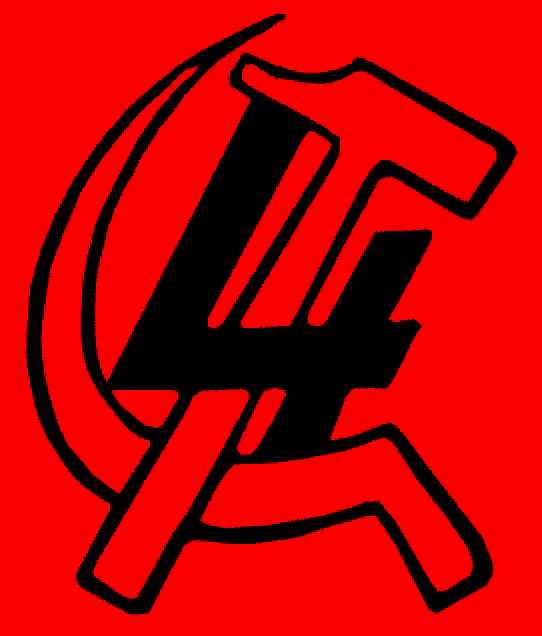
December 2004
The Rape of Falluja: U.S. War Crime
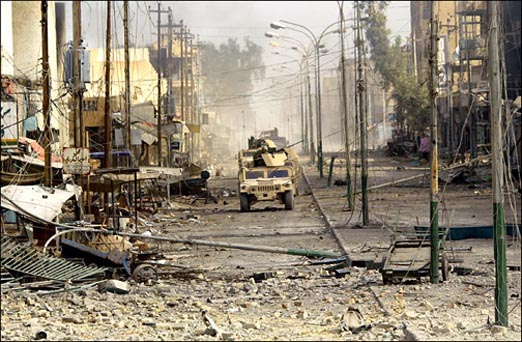
Marines ride down main
street in Falluja on November 14, after a week of bombardment
and wholesale destruction of the city by U.S. troops. Photo: Patrick Baz/Agence France-Presse
After the
American “terror
war elections” came the post-election U.S. terror attack in Iraq.
George Bush
figured he would celebrate his reelection with a bang: send the Marines
into
the Iraq rebel stronghold of Falluja and flush out the varmints. That
would
show the world that he means business. At mid-day on Wednesday,
November 3,
Democrat John Kerry conceded the election in a phone call to the White
House.
By Saturday, November 6, the assault on Falluja began. U.S. rockets
took out
their first target: the Hai Nazal Hospital, a new facility that was
just about
ready to open its doors. A spokesman for the First Marines
Expeditionary Force
said, “A hospital was not on the target list.” But there it is, reduced
to a
pile of rubble. Then on Sunday night the Special Forces stormed the
Falluja
General Hospital. They rounded up all the doctors, pushed them face
down on the
floor and handcuffed them with plastic straps behind their backs. With
the
hospital occupied, those wounded by the U.S. aerial bombings headed to
the
Falluja Central Health Clinic. And so at 5:30 a.m. on Tuesday, November
9, U.S.
warplanes bombed that clinic as well, killing 35 patients, 15 medics, 4
nurses,
5 support staff and 4 doctors, according to a doctor who survived (The
Nation, 13 December). U.S. fire also targeted an ambulance, killing
five
patients and the driver.
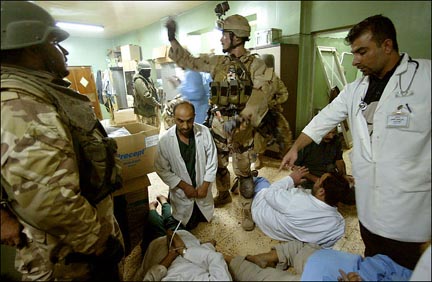 Doctors
at Falluja General Hospital handcuffed and pushed to the floor when
U.S. troops seize the facility, November 8. (Photo: New York
Times)
Doctors
at Falluja General Hospital handcuffed and pushed to the floor when
U.S. troops seize the facility, November 8. (Photo: New York
Times)
“The
hospital was selected
as an early target because the American military believed that it was
the
source of rumors about heavy casualties,” when the U.S. attacked
Falluja in
April, wrote the New York Times (8 November). “It’s a center of
propaganda,” a senior American officer said. Rumors? Propaganda? Iraq
Body
Count, whose tallies of Iraqi dead since the invasion have been
extremely
conservative, has done a detailed analysis of all available figures,
concluding
that out of 800-plus persons killed during the U.S.’ April attack (336
buried
in Falluja’s soccer stadium), some 600 were civilians, half of them
women and
children.1 A hospital is a place where civilian casualties
could receive
treatment. But
according to the U.S. military spokesmen, there were “no civilian
casualties,”
so no hospital was needed. Likewise, a hospital is a place where
injured Iraqi
insurgents might be treated. But the objective of the assault on
Falluja was to
kill the insurgents, every last one, so again, no hospital was needed.
The
Fourth Geneva Convention on Warfare declares in no uncertain terms,
“Civilian
hospitals organized to give care to the wounded and sick, the infirm
and
maternity cases, may in no circumstances be the object of attack but
shall at
all times be respected and protected by the Parties to the conflict.”
That was written
in 1949, after World War II. The Geneva Conventions also outlaw
practices like
torture of prisoners. But according to the White House legal counsel,
Alberto
Gonzales, now promoted to Attorney General of the United States, the
strictures
of the Geneva Convention are outdated and “quaint.”
So
doubtless after careful
study by the Center for Army Lessons Learned at Fort Leavenworth,
Kansas, the
Pentagon’s first rule in its terrorist “war on terror” is now: hit
the
hospitals first. There are to be no statistics about women and
children
killed, no pictures of maimed bodies, no medical care for the insurgent
or
civilian wounded. The “born again” Christian George W. Bush goes by the
mercenary motto, “Kill ’em all and let god sort ’em out.” But it isn’t
just Republican
Bush. In the 1999 war on Yugoslavia, by Democrat Bill Clinton, the U.S.
deliberately bombed the Belgrade maternity hospital, all the while
cynically
claiming that no hospital was on the target list. (They also targeted
the
Chinese embassy, to teach Beijing a lesson, lamely claiming they got
the
address mixed up with a military warehouse.) In short, the political
and
military commanders of the United States are rabid mass murderers and
torturers, and conscious war criminals to boot. U.S. imperialism with
its mad
dog leadership is, by far, the greatest threat
to humanity
today. The colonial occupation of Iraq (and Afghanistan) must be
defeated, and
the imperialist system smashed through world socialist revolution.
Moreover,
the attack on
Falluja was a bipartisan massacre, which had the support of
both major
parties of American capitalism. During the first debate (September 30)
of the
recent U.S. presidential election campaign, Democratic candidate John
Kerry
accused Bush of backing down from the assault on Falluja last April. At
that
time there was a worldwide outcry over the slaughter of innocent
civilians that
forced the Pentagon to back off. But Kerry argued that the Bush people
“don’t
think these things through properly,” and “you have to do that by
beginning to
not back off of Falluja and other places.” Neither the Democratic
candidate nor
any of the other liberal mouthpieces said a word against the recent
criminal
assault on Falluja, which they fully supported. The
conservative Wall
Street Journal (17 November) hailed the “Victory at Fallujah”
while the
liberal New York Times (22 November) wrote of the “swift and
stunning
American military sweep through Falluja,” but worried about the “Costly
Troop
Deficit in Iraq.” As Kerry did in the presidential campaign, the Times
(8
November) called for sending in more U.S. soldiers, some
40,000 more, to
keep the Iraqis down. On December 1, the Pentagon announced it was
increasing
U.S. forces in Iraq by 12,000 by keeping troops there longer.
The
martyrdom of Falluja
began immediately following the U.S. invasion in April 2003, when
occupation
forces fired on a protest demonstration, killing 18 (see “Defeat
Colonial
Occupation of Iraq!” The Internationalist No. 16, May-June
2003). The
assault a year later was a U.S. revenge attack over the killing of four
mercenaries (referred to in the press as “contractors,” as if they were
house
builders rather than professional killers) from the Blackwater Security
rent-a-merc company, whose bodies were mutilated and strung up from the
railroad bridge. The April 2004 assault was already a U.S. war crime,
reminiscent of Nazi “collective punishment” of the Czech town of Lidice
where Reichsprotektor and deputy Gestapo chief Reinhard
Heydrich was killed by
partisans in 1942.
But that pales in comparison to the celebration of Bush’s reelection by
gutting
an entire city of more than 250,000 inhabitants. According to
Washington,
Falluja had to be “pacified” and “secured” so that it could participate
in the
Iraqi “election” scheduled by occupation authorities for January. To
believe
that lie one would have to be clinically insane, but that didn’t stop
the
imperialist media from solemnly repeating this story that none of them
believe.
The fact is there will be no vote in Falluja in January: insurgents
continue to
ambush the U.S. occupiers, civilians won’t even be allowed to return to
their
destroyed homes for weeks. It will take years to rebuild the devastated
city.
More than
25,000 U.S.
troops were pulled in to surround Falluja, 15,000 of them ready to
storm the
rebel citadel. Plus another couple thousand soldiers and police of the
puppet
Iraqi pseudo-government of “prime minister” Iyad Allawi, half of whom
walked
out before the fighting began. Interestingly, as he was giving a pep
talk to
2,500 troops lined up before going in for the kill, Sgt. Maj. Carlton
Kent, the
top enlisted Marine in Iraq, compared the coming battle to the bloody
U.S.
assault on the Vietnamese city of Hue in March 1968, trying to take
back the
ancient Vietnamese capital from the Viet Cong (the Vietnamese
Communists), who
had seized it during the Têt offensive. “You're all in the
process of making
history,” Kent told them. “This is another Hue city in the making. I
have no
doubt … that each and every one of you is going to do what you have
always done
– kick some butt.” He neglected to mention that although the U.S.
managed to
“take back” Hue, the Têt offensive was a turning point in Vietnam
as it became
evident even to sections of the American ruling class that they
couldn’t win
that dirty imperialist war. Now various people in the Bush
administration are
talking about Falluja as the “tipping point” in the Iraq war. But it
isn’t
tipping in their favor. Falluja was, as the German news magazine Der
Spiegel
(22 November) titled its story “A Catastrophic Victory,” echoing Bush’s
description of the 2003 U.S. invasion as a “catastrophic success.”
It took the
U.S. troops
about 8 days to go down three main streets in Falluja from north to
south,
advancing about a quarter mile a day. The Iraqi defenders put up what
the
Marine division commander termed a “a very stiff and determined
resistance” (Christian
Science Monitor, 26 November) against overwhelming firepower and
technology. Snipers kept emerging from the rubble to take out U.S.
troops.
Insurgents dressed in Iraqi army uniforms set up ambushes where they
shot the
attackers. The Pentagon has admitted to 51 U.S. soldiers killed in
Falluja
proper, and 425 wounded, which seriously understates U.S. losses. The Wall
Street Journal reported over 100 U.S. soldiers dead and 900
seriously
wounded in the ten days following the start of the assault on Falluja,
including those killed and injured in the upsurge of fighting in Mosul,
Ramadi,
Samara, Taji and other cities in central and northern Iraq. A New
York Times
reporter who was “embedded” with one Marine company wrote that it took
36
casualties during the fighting, 25 percent of the company’s strength; a
Christian
Science Monitor says his unit sustained losses of 20 percent. A
standard calculation
for battlefield commanders is that with a 10 percent casualty rate, a
unit may
be “neutralized,” no longer capable of fighting (U.S. Army, FM 17-18, Light
Armor Operations). So the battle for Falluja took quite a toll on the
attackers, whatever the Pentagon brass may pretend.
In spite of
all this,
fighting is still going on in Falluja, as guerrilla squads pop up
behind the
U.S. troops in the neighborhoods that have supposedly been “cleared” of
insurgents. Meanwhile, throughout the areas of Iraq populated by Sunni
Arabs –
the central region including Baghdad and the key oil producing area of
the
north – insurgents have launched an offensive against the colonial
occupiers
and their puppet soldiers and police. In the city of Mosul, while the
fighting
was at its height in Falluja, rebels took over nine police stations and
held
the center of the city for several days, killing scores of cops and
troops of
the quisling regime. The Iraqi police melted away: only 800 out of
4,000 stayed
at their posts. So much for “Iraqization” of the war – U.S. troops are
going to
have to occupy the cities as long as the occupation lasts, making them
constant
targets in a war in which there are no fronts and no safe rear areas.
Mortar
attacks regularly hit the cordoned-off Green Zone in the capital where
the U.S.
expeditionary force and its Iraqi “government” have their HQ. The
highway to
the Baghdad airport is one of the deadliest stretches of road in the
country.
Already, U.S. troops have mutinied over being sent on a “suicide
mission,” as a
fuel platoon from the 343rd Quartermaster Company did in mid-October,
for which
17 soldiers were arrested and may be court-martialed.
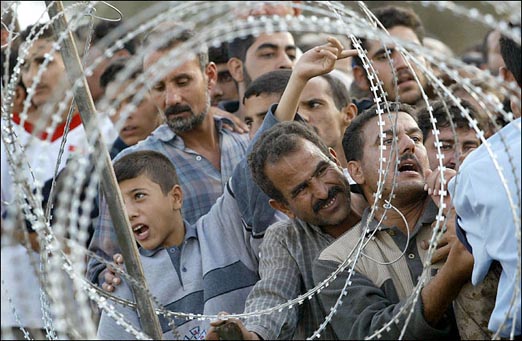
Refugees who fled Falluja before the attack: thousands line up for food outside
military base at Habbaniya, Iraq. (Photo: Shawn Baldwin/New York Times)
What about
the Iraqi
insurgents and civilians killed in Falluja? At the outset of the attack
on Iraq
in March 2003, U.S. commander Tommy Franks declared, “We don’t do body
counts.”
His reluctance was a legacy of the Vietnam War when the body counts of
“VC
dead” that were daily announced by General Wastemoreland, as he came to
be
known, were notorious for their lies. Body counts or no, during the
fighting in
Falluja local commanders claimed that they had killed 3,000 insurgents,
later
reduced to 1,200. Reporters questioned the figure. But were they rebel
fighters? The New York Times (15 November) commented: “The
absence of
insurgent bodies in Falluja has remained an enduring mystery.” So whose
bodies
were lying in the streets for days, “half-eaten by dogs”? Lt. Gen. John
F.
Sattler, commander of the First Marine Expeditionary Force, “said that
he did
not know of any civilian deaths,” according to the Times (20
November).
Yet the International Committee of the Red Cross reported that some 800
of
those dead were civilians – i.e., the overwhelming majority – many of
them
buried alive when their homes were shelled by artillery or destroyed by
the 500
and 2,000 lb. bombs that the Air Force has been dropping on
neighborhoods day
and night. The few pictures that have been released show a scene of
utter
devastation, an entire city laid waste. Over half the 100-plus mosques
in
Falluja were severely damaged or destroyed.
As the
photos of hideous
torture at Abu Ghraib prison became the symbol of the imperialists’
obscene
torture of Iraq, the storming of Falluja was summed up in the video of
a U.S.
soldier murdering an unarmed and wounded Iraqi prisoner in a mosque. A
righteous rage at the cold-blooded executioners swept Iraq and Near
East as the
scene was played at length on TV, over and over (only a snippet was
shown in
the U.S., blacking out the shots of the bullet hitting the prisoner’s
head and
blood splattering as “too gruesome”). Defenders of the imperialist war
and
colonial occupation cynically argued that perhaps the soldier was
afraid for
his life, who knows, and besides the Iraqi prisoners were “people
without morals.”
The cameraman who filmed it said the prisoner made no threatening
moves, and it
is likely that four other wounded prisoners in the mosque were killed
at the
same time. He recounts that as the Marines emerged, a lieutenant asked
“did you
shoot them,” to which a soldier replied, “Roger that, sir.” Asked if
the
prisoners were armed, the Marine shrugged. The inescapable conclusion
is that
the soldiers were obeying orders or following standard operating
procedure in
shooting the prisoners. A journalist who had accompanied a Marine unit
during
the 2003 invasion immediately recognized the practice:
–“Dead Check in Falluja,” Village Voice, 24 November
The rape of Falluja was
a heinous criminal act, a war crime worthy of the Nazis. In addition to the Czech town of Lidice, it
recalls
the martyrdom of Guernika in 1937 during the Spanish Civil War, a
massacre
immortalized in Picasso’s painting of a cry of anguish, where the
Basque town
was pounded into rubble by 100,000 pounds of bombs while German
Messerschmitt
dive bombers strafed those trying to flee the carnage. The obliteration of
Falluja was a war crime worthy of Zionist Israel, which
bombed the
Palestinian refugee camp at Jenin into oblivion after an Israeli tank
was taken
out by intifada fighters. The Zionist army continues to carry
out
Nazi-style “collective punishment” in the West Bank and Gaza, killing
hundreds
of Palestinian civilians, including shooting school girls in uniform
point-blank. Much of the Pentagon’s “strategy” and tactics in Iraq are
in fact
borrowed from the Israelis, including blasting in every house entered,
allegedly to avoid booby-trapped doors. But more to the point, the
destruction of Falluja was a hideous war crime worthy of U.S.
imperialism.
The
destruction of Falluja
inevitably calls to mind the words attributed to a U.S. officer in
Vietnam at
the time of the Têt offensive: “we had to destroy the village in
order to save
it.” That certainly is the mentality of the U.S. military in Iraq
today. In
Vietnam, the United States killed upwards of 3 million Vietnamese
during eight
years of war. In the Korean War, the U.S. slaughtered more
than 2 million Koreans. In World War II, the
U.S. notoriously slaughtered more than 200,000 Japanese with the atomic
bombs
that destroyed Hiroshima and Nagasaki in August 1945. This came after
the
deliberate firebombing of Tokyo in March 1945, in which the U.S.
murdered more
than 100,000 people. Or the U.S./British firebombing of Dresden,
Germany in
February 1945 (150,000 to 225,000 dead, almost all civilians and
wounded
soldiers), part of the Allied imperialists’ systematic campaign of
terror
bombing German cities in the latter part of World War II which killed
an
estimated 635,000 German civilians. (See “The
Great Chemical Weapons
Hoax” and “U.S./British
Massacre at Dresden” in The Internationalist No.
16,
May-June 2003.) Not to mention the countless bloody crimes of Yankee
imperialism in Latin America: Bay of Pigs invasion, Pinochet coup in
Chile,
contra terror war on Nicaragua, death squads in El Salvador, the rape
of
Grenada, the invasion of Panama, etc.
Already in
Iraq, a study by
the Center for International Emergency Disaster and Refugee Studies of
the
Johns Hopkins Bloomberg School of Public Health, published in the
British
journal of international medicine, The Lancet (29 October), has
concluded that “about 100,000 excess deaths, or more have happened
since the
2003 invasion of Iraq.” This is in addition to the estimated 1.5
million Iraqis
who died as a result of the draconian United Nations “sanctions”
following the
1990-91 Gulf War, including a million children who died of malnutrition
and
preventable diseases, far more than the estimated 130,000 Kurds,
Shiites and
communists killed by the murderous former U.S. henchman, Saddam
Hussein. After
the worldwide outcry earlier this year over U.S. torture of prisoners
at Abu
Ghraib, the imperialists try to justify the slaughter at Falluja by
pointing to
the grisly beheadings of hostages by Islamic fundamentalist groups.
Beyond the
fact that many, if not most, of the hostages work in one way or another
for the
colonial occupation regime, and that the upsurge of Islamicist outfits
(both
Sunni and Shiite) is a direct response to the imperialist war of
conquest of Iraq,
one can safely say that far more Iraqis have been beheaded by the
imperialist
barbarians with their high tech weaponry than by the medievalist Sunni
zealots
with their swords. Accounts of the carnage in Falluja mention quite a
number of
civilian dead with their heads and limbs blown off by U.S. bombs, but
photos of
that are never shown.
|
Falluja Massacre, April 2004
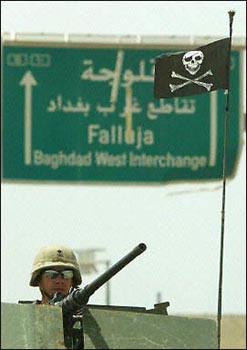 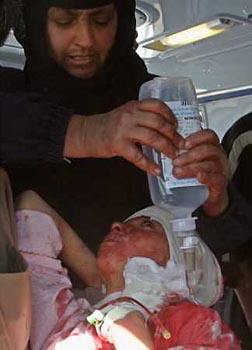 Scenes
from the murderous U.S. assault on Falluja in April. Flag on U.S.
vehicle
sums up “Kill ’em all” mentality of troops. Marine commanders
assert hospitals were source of propaganda about high casualties, so
they had to occupy hospitals first. But investigation by Iraq Body
Count showed that some 600 out of 800 deaths due to the attack on
Falluja were civilians. Photos (censored from U.S. media) showed
numerous wounded children and babies killed by bombing.
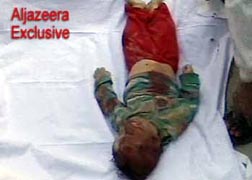 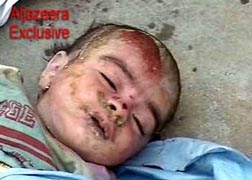  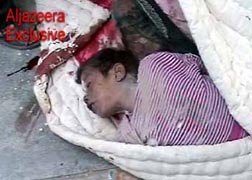 |
One could
endlessly recount
the endless atrocities committed by the U.S. in Iraq, which have been
systematically suppressed by the “free but responsible” bourgeois
media. What’s
key is to draw the political lessons, beginning with the fact that this
is
not just “Bush’s war,” as so many of the opportunists and
pseudo-socialists
say, it is a war of U.S.
imperialism. They want to blame it all on the
Republicans in order to sidle up to the antiwar Democrats. But with his
“we can
do better” rhetoric, Kerry was promising to continue the war. Nader,
for his
part, didn’t even call for immediate withdrawal of U.S. troops from
Iraq, but
for an “intelligent” withdrawal over six months and their replacement
by
European imperialist troops. Whether they have U.S. flags on their
uniforms or
NATO shoulder patches or United Nations blue helmets, it would still be
a
colonial occupation, and the Iraqis would still be right to try to
drive them
out. In this war, class-conscious workers the world over have a side: with
the Iraqi people against the imperialist attackers and their colonial
occupation. With Lenin and Trotsky, the League for the Fourth
International
holds that in an imperialist war on a semi-colonial or colonial
country, it is
a matter of elementary class principle
to stand for defense of Iraq, and
Afghanistan, and all the targets
of U.S. and British imperialism, and to fight for the defeat of the
imperialists.
The current
war is the
product not of a president or a policy or a particular party, but of a
system
which has produced an endless string of wars over the last century,
from the
Spanish-American War to the First World War to the Second World War to
the
Korean War in the 1950s to the Bay of Pigs invasion of Cuba and the
Vietnam War
in the ’60s, to the Afghanistan War and the contra war in Central
America in
the ’80s, to two wars against Yugoslavia in the ’90s (in 1995 over
Bosnia and
in 1999 over Kosovo) to the Afghanistan War in 2001 and the Iraq War in
2003,
both of which are continuing. That system is imperialism, which as
Lenin
pointed out is the stage of capitalism when it has outgrown national
boundaries
and spreads its tentacles throughout the world, sucking surplus value
out of
the sweat and toil of impoverished workers from El Salvador to the
Philippines,
controlling sources of raw materials from Brazil to Nigeria to the Near
East.
The present war is not about Saddam Hussein, the former U.S. running
dog who
slipped the leash, who started out killing Iraqi communists by the
hundreds
with lists supplied by the CIA, and then used chemical weapons
furnished by the
U.S. to prevent the Iranians from reaching the Saudi oil fields. The
war was
not about “weapons of mass destruction” which Hussein didn’t have, as
was clear
at the time, and which the U.S. has in abundance and has used with
abandon.
Falluja is
ground zero of
the U.S. war for imperialist domination of the planet. It will not be
stopped
simply by denouncing the atrocities and having a bigger and better
antiwar
movement. Peace parades down Fifth Avenue or circling Madison Square
Garden
won’t stop the Special Forces and Marine expeditionary forces.
Bolsheviks are
not pacifists, and call instead for class
war against the imperialist war.
The imperialists have to be defeated, on the battlefield in Iraq and
elsewhere,
above all through the mobilization of the social force that has the
power to
sweep away imperialism and bring the capitalist machinery of
exploitation and
oppression to a grinding halt. That force is the international working
class,
and the League for the Fourth International has fought to mobilize the
power of
the proletariat since the beginning of the war. We have called for and
fought
for workers boycotts of military cargos,
concretely among rail and dock
workers in Europe and among West Coast longshoremen in the United
States, and
for workers strikes against the war.
Already in Europe in the lead-up to
the attack on Iraq, train drivers in Scotland refused to move munitions
trains
while Italian rail workers and antiwar groups blocked railroad tracks
to block
trains carrying jeeps, tanks, helicopters and other heavy equipment
bound for
the Persian Gulf. As the war drags on and casualties mount, the
possibilities
of working-class action against the imperialist slaughter will rise
sharply.
In the
U.S., when shippers
of war goods were picketed in the port of Oakland, California, police
savagely
attacked demonstrators, firing on them with “non-lethal” ammunition,
injuring
half a dozen longshoremen and arresting 25. The charges against them
were
dropped a year later. Last March 20, the ILWU itself held a token work
stoppage
protesting the war. What’s necessary is to go beyond such gestures to a
knock-down, drag-out fight. It’s necessary to drive home the lesson
that you can’t
fight Bush with Democrats. Moreover, any capitalist party is
part of the
imperialist system, whether it’s the red-white-and-blue Greens (who
only ran in
“safe” states where they wouldn’t threaten the vote for Kerry), or oil
millionaire Nader, who ran on the ticket of the right-wing Reform
Party, went
after so-called “illegal aliens” and vituperated against the
“totalitarian”
Chinese deformed workers state. It is necessary to hammer home that
what’s
necessary is to build a revolutionary workers party, a
party that shows
how the war on Iraq is a war on working people, blacks, Latinos and
immigrants
“at home,” and which puts forward a program to sweep away the
capitalist system
that breeds war, poverty and racism. Such a party must be what Lenin
called a tribune
of the people, that doesn’t just fight over economic issues but
takes up
the cause of the oppressed over every abuse and every attack.
The rape of
Falluja must be
avenged by Iraqis fighting to drive out the imperialist invaders and by
the
workers of the world, fighting to defeat the bosses’ war that targets
all the
exploited and oppressed. n
To contact the Internationalist Group and the League for the Fourth International, send e-mail to: internationalistgroup@msn.com